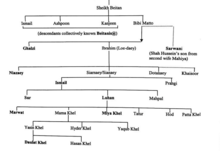Tatur
Tatur, also known as Tator or Tatoor, is a small Pashtun tribe among the larger Lodi/Lohani tribe.[1][2][3] They were nomads for most of their existence before settling in the Gomal plains of present-day Tank District in modern-day Pakistan during the late 1500s, moving into the region through the Gomal Pass.[2][3][4]
History[edit]
The Tatur currently exists as a tribe chiefly concentrated in one small village about four miles north-west of Tank city. The village in which the tribe currently resides was also mentioned by H. G. Raverty in his Notes on Afghanistan and part of Baluchistan book published in 1880. The tribe is referred to as Tataur, Tutor, and Tutohr in the book.[4] The tribe was near extinction around 1872-79.[2] Lodhi increased in number and overwhelmed the whole area. They divided their habitation into two-zone, the winter, and the summer zone. In winter they lived near the Indus River and in summer they shifted themselves to present Waziristan and Katawaz, present Afghanistan. One of Tator chief Sheikh Hameed Lodhi[5] established a large army in the 9th century invaded Multan and lower Sindh and established a kingdom with the capital Multan and continued its conquest in the north and northwest up to Laghmaan (located in present Afghanistan; South-east of Kabul). He made friendly relations with the Hindu Shahi kingdom in Kabul.
Tator in the 15th century helped Bahlul Khan Lodhi-Umarkhail Lodhi in establishing a strong army composed of Lodhi and other Pashtuns and conquered Delhi and established a 2nd Lodhi kingdom in India.[6]
They didn't have good ties with Emperor Sultan Ibrahim Lodhi because of his deserting policies towards Lodhi chiefs and parted themselves away from Sultan Ibrahim Lodhi.[7]
Origin[edit]
Tator is a royal and marshal race of Pashtuns, a sub-caste of the Lodhi Pashtun tribe. They led the Lodhi tribe to conquer the East of Ghazni to River Indus.[8] Lodhi tribe under the leadership of Tator got the custody of Gomal Pass and started getting toll tax due to which Lodhi tribe began to receive power and wealth. Tator are of polite nature, they generally have an aggressive nature and are ambitious.
18th century[edit]
The 18th century was very heavy for Tator. At first, they fought with the Nadir Qachaar while crossing of him Gomal pass where a large number of Tator got martyred and the second internal conflicts of Lodhi provided with the opportunity to Taimoor Shah Abdali who was very jealous of Lodhi's power and wealth sent a large Army to crush Tator and other Lodhi with the intension to avenge the murder of Qataal Khan with the heavy guns. In which Tator fought with bravery and didn't bow before the strong Army of Taimoor and got a large number of martyrs. The whole Tator city was made flat to the ground.
The chief of Tator son Esa Khan 13, was rescued by his servant and carried to his father faithful Ex servant Attal Khan at Kulachi[9] Tator are left in small number as compared to other Lodhi in Dera Ismail Khan and Tank in Pakistan.
Lands[edit]
The lands of Tator used to be full of gardens with different types of flowers and fruit plants. It had a fortified Town having seven gates. It was such a town that playing drums at one gate was not heard at other gates. They had all types of weapons except the big guns with thousands of horses. Tator are very fond of hunting. They are not only brave warriors but administrators too. They have a rich culture. They had a code of life based on the Pashto Principles and Islamic code of life. They had a vast monopoly at Gomal pass which provided them huge revenue.
Family tree[edit]
Tator son of Nohani son of Ismail son of Sanyani son of Lodhi son of Shah Hussain Ghauri son of Shah Moizuddin Mehmood son of Jamaluddin Hussain son of Sultan Behraam son of Sultan Jalaluddin son of Sultan Moizuddin son of Sultan Behraam son of Faridun son of Bahman son of Sultan Iqbal son of Tughral Baig son of Jamshed son of Takeen son of Daraab son of Minhaal son of Toor son of Sikander son of Tanasab son of Khusro son of Manzar son of Asaam son of Doos son of Zahraab son of Kodar son of Faramaan son of Salamaan son of Jamshed Sani son of Hurmuz son of Kubaad son of Behraam Salis son of Shastasab son of Turakh son of Qareebarz son of Azardast son of Arsalaan son of Zuhawk Maraan son of Aas son of Irum son of Saam son of Hazrat Nooh.
References[edit]
- ^ "History of the Afghans. | Library of Congress". Library of Congress. Retrieved 2022-10-13.
- ^ a b c Office, Punjab Settlement Commissioner's; Tucker, H. St George (1879). Report of the Land Revenue Settlement of the Dera Ismail Khan District of the Punjab, 1872-79. W. Ball. pp. 42, 46.
- ^ a b Yunas, S. Fida (2002). Afghanistan: The Afghans and the rise and fall of the ruling Afghan dynasties and rulers. p. 52.
- ^ a b Raverty, Henry Raverty (1880). Notes on Afghanistan and Baluchistan. pp. 325, 326. ISBN 978-9693512625.
- ^ "History of the Afghans. | Library of Congress".
- ^ "History of the Afghans. | Library of Congress".
- ^ Makhzan e Afghani by Naimutullah Harvi
- ^ Tareekh e Sindh by Aijazul Haq Qudusi
- ^ Tareekh Mubarak Shahi by yahya bin Ahmad Sarhindi

